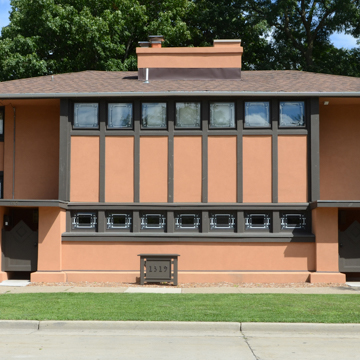The Hardy House encapsulates Wright’s hallmark design elements with long, flat lines, a low hipped roof, a squat chimney, window ribbons, and canopies that evoke the prairie horizon. The geometric art-glass windows typify Wright’s turn-of-the-twentieth-century work. And as in many of his residential designs, the house turns its back to the street, guarding the family’s privacy and offering passersby a plain, stucco-clad, mostly solid wall. Much of this building can be seen only from the lake. The steep-sloping lot overlooking Lake Michigan allowed Wright to layer the structure down the hillside. A dramatic two-story glass wall faces the water, providing expansive views from the cathedral-ceilinged living room. From the top floor, containing bedrooms, a balcony overlooks the living room and the lake. Four doors lead from the dining room onto a terrace, and a basement level, invisible from the street, opens to the hillside. The building thus embodies another of Wright’s favorite ideas: breaking down the box to bring the outdoors inside. Gene Szymczak, the seventh owner, rehabilitated the house in 2012–2015, down to its original colors.
You are here
Thomas P. Hardy House
If SAH Archipedia has been useful to you, please consider supporting it.
SAH Archipedia tells the story of the United States through its buildings, landscapes, and cities. This freely available resource empowers the public with authoritative knowledge that deepens their understanding and appreciation of the built environment. But the Society of Architectural Historians, which created SAH Archipedia with University of Virginia Press, needs your support to maintain the high-caliber research, writing, photography, cartography, editing, design, and programming that make SAH Archipedia a trusted online resource available to all who value the history of place, heritage tourism, and learning.


